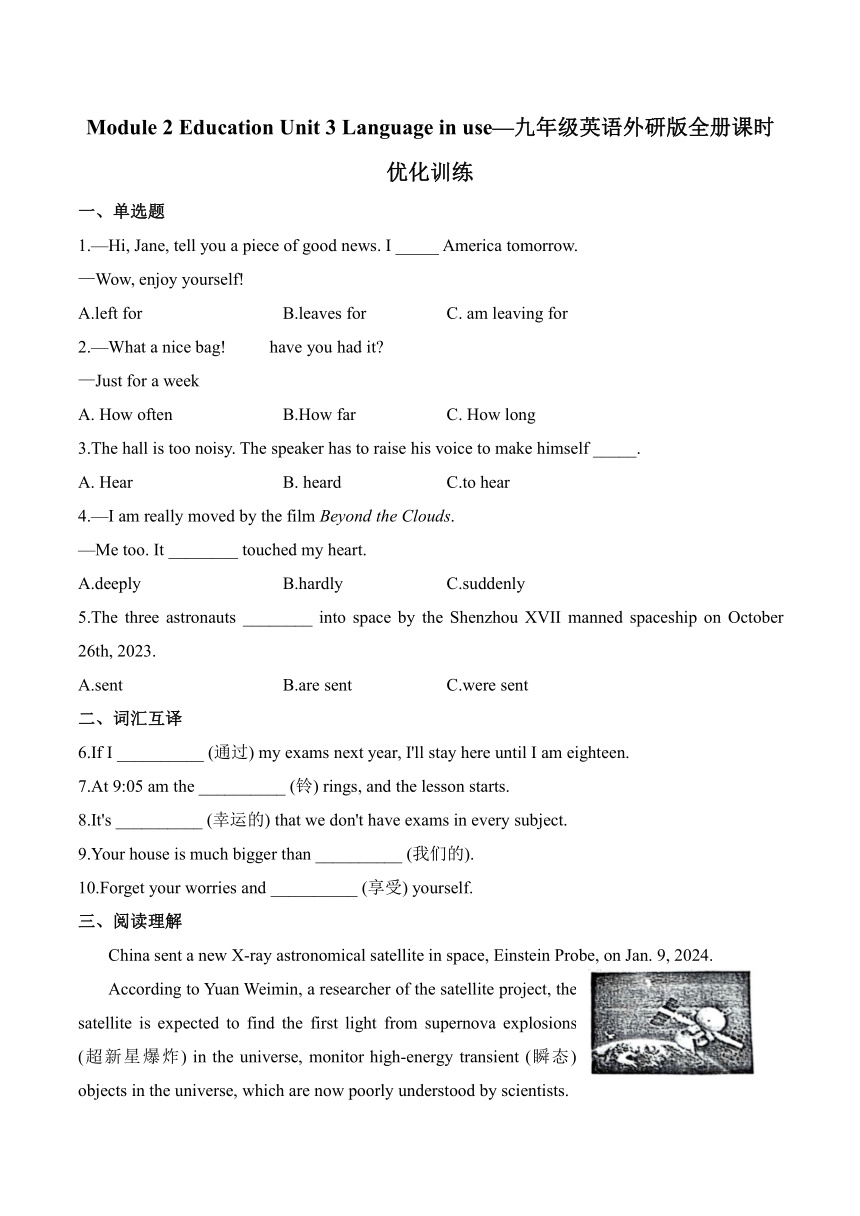
Module 2 Education Unit 3 Language in use—九年级英语外研版全册课时优化训练 一、单选题 1.—Hi, Jane, tell you a piece of good news. I _____ America tomorrow. —Wow, enjoy yourself! A.left for B.leaves for C. am leaving for 2.—What a nice bag! have you had it —Just for a week A. How often B.How far C. How long 3.The hall is too noisy. The speaker has to raise his voice to make himself _____. A. Hear B. heard C.to hear 4.—I am really moved by the film Beyond the Clouds. —Me too. It _____ touched my heart. A.deeply B.hardly C.suddenly 5.The three astronauts _____ into space by the Shenzhou XVII manned spaceship on October 26th, 2023. A.sent B.are sent C.were sent 二、词汇互译 6.If I _____ (通过) my exams next year, I'll stay here until I am eighteen. 7.At 9:05 am the _____ (铃) rings, and the lesson starts. 8.It's _____ (幸运的) that we don't have exams in every subject. 9.Your house is much bigger than _____ (我们的). 10.Forget your worries and _____ (享受) yourself. 三、阅读理解 China sent a new X-ray astronomical satellite in space, Einstein Probe, on Jan. 9, 2024. According to Yuan Weimin, a researcher of the satellite project, the satellite is expected to find the first light from supernova explosions (超新星爆炸) in the universe, monitor high-energy transient (瞬态) objects in the universe, which are now poorly understood by scientists. When developing the satellite, a new generation of detection equipment (探测设备) with large fields of view and high sensitivity (灵敏度) was needed. But the important question was how to make such equipment. Lobsters (龙虾) are a kind of sea animal which can be found around the world. Scientists discovered early on that lobsters’ eyes are different from other animals’. Lobsters’ eyes are made up of lots of tiny square tubes, pointing to the same center, which allows light from all directions to reflect in the tubes and meet on the retina (视网膜), which gives lobsters a large field of view. Scientists then simulated (模仿) the lobsters’ eyes to create a telescope to catch X-rays in space. Through working together with other organizations, the X-ray Imaging Laboratory began the research and development work on lobster-eye X-ray imaging technology in 2010 and finally made a breakthrough. “Thanks to the lobster-eye telescope technology, the Einstein Probe is able to monitor the poorly known soft X-ray band with a large field of view and high sensitivity,” Yuan said. 11.What is Einstein Probe A. A newly-found planet. B. A newly-built space station. C. A new X-ray astronomical satellite. 12.Why was Einstein Probe sent in space A. To enlarge the field of view. B. To catch the supernova explosion. C. To monitor the sensitivity of objects. 13.How did scientists create the telescope technology A. By simulating the lobsters’ eyes. B. By observing lobsters’ movement. C. By doing experiments on sea animals. 14.What can we infer from the passage A. The new detection equipment looked like a lobster. B. China is ... ...
~~ 您好,已阅读到文档的结尾了 ~~